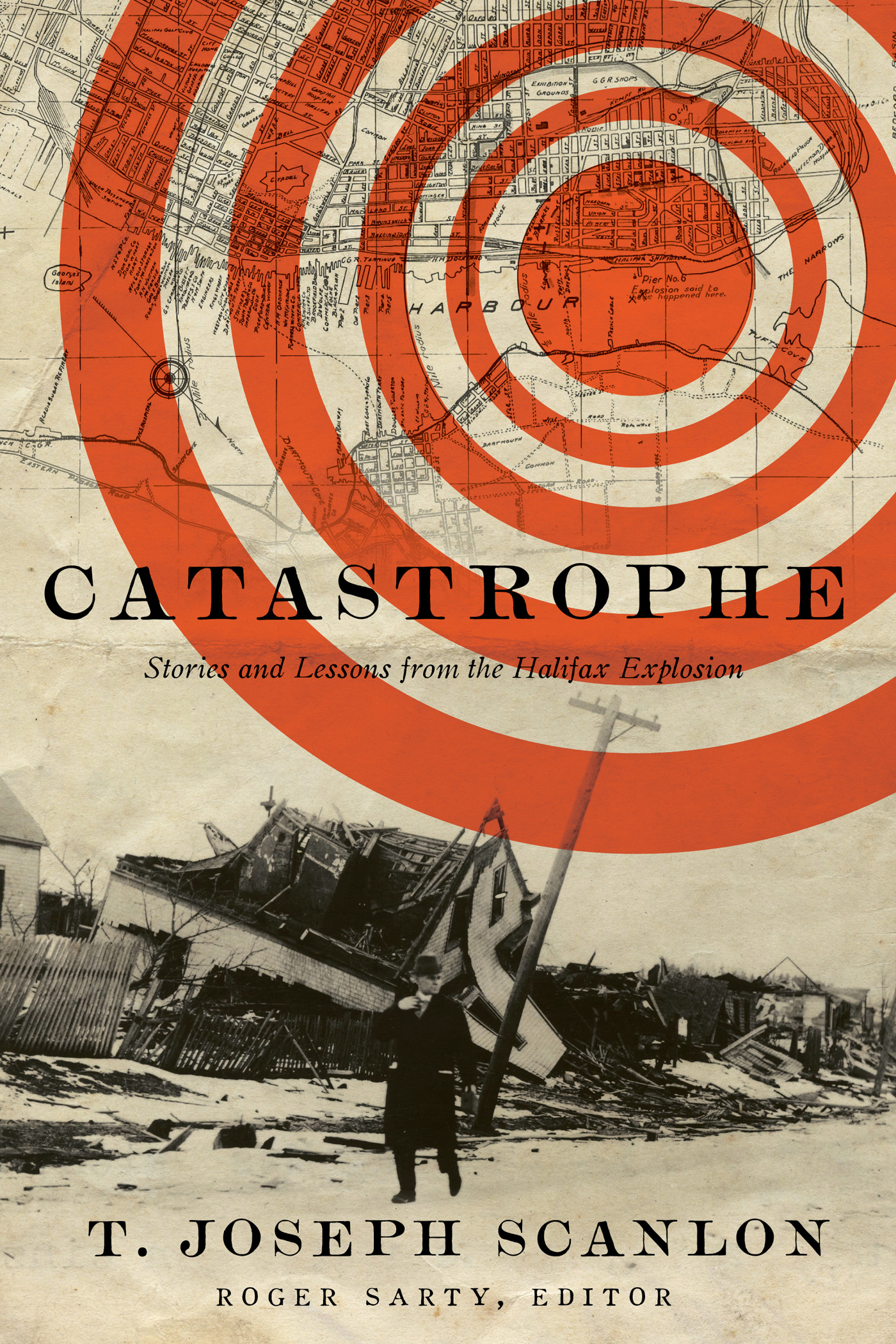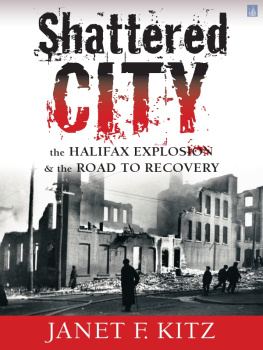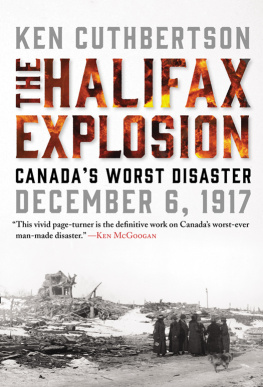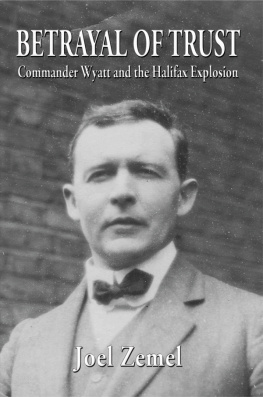T. Joseph Scanlon - Catastrophe: Stories and Lessons from the Halifax Explosion
Here you can read online T. Joseph Scanlon - Catastrophe: Stories and Lessons from the Halifax Explosion full text of the book (entire story) in english for free. Download pdf and epub, get meaning, cover and reviews about this ebook. year: 2020, publisher: Wilfrid Laurier University Press, genre: Politics. Description of the work, (preface) as well as reviews are available. Best literature library LitArk.com created for fans of good reading and offers a wide selection of genres:
Romance novel
Science fiction
Adventure
Detective
Science
History
Home and family
Prose
Art
Politics
Computer
Non-fiction
Religion
Business
Children
Humor
Choose a favorite category and find really read worthwhile books. Enjoy immersion in the world of imagination, feel the emotions of the characters or learn something new for yourself, make an fascinating discovery.

- Book:Catastrophe: Stories and Lessons from the Halifax Explosion
- Author:
- Publisher:Wilfrid Laurier University Press
- Genre:
- Year:2020
- Rating:3 / 5
- Favourites:Add to favourites
- Your mark:
- 60
- 1
- 2
- 3
- 4
- 5
Catastrophe: Stories and Lessons from the Halifax Explosion: summary, description and annotation
We offer to read an annotation, description, summary or preface (depends on what the author of the book "Catastrophe: Stories and Lessons from the Halifax Explosion" wrote himself). If you haven't found the necessary information about the book — write in the comments, we will try to find it.
Catastrophe: Stories and Lessons from the Halifax Explosion — read online for free the complete book (whole text) full work
Below is the text of the book, divided by pages. System saving the place of the last page read, allows you to conveniently read the book "Catastrophe: Stories and Lessons from the Halifax Explosion" online for free, without having to search again every time where you left off. Put a bookmark, and you can go to the page where you finished reading at any time.
Font size:
Interval:
Bookmark:

Stories and Lessons from the Halifax Explosion
T. JOSEPH SCANLON
EDITED BY ROGER SARTY

Wilfrid Laurier University Press acknowledges the support of the Canada Council for the Arts for our publishing program. We acknowledge the financial support of the Government of Canada. This work was supported by the Research Support Fund.

Library and Archives Canada Cataloguing in Publication
Title: Catastrophe : stories and lessons from the Halifax Explosion / T. Joseph Scanlon ; edited by Roger Sarty.
Names: Scanlon, Joseph, author. | Sarty, Roger, 1952- editor.
Description: Includes bibliographical references and index.
Identifiers: Canadiana (print) 20200297503 | Canadiana (ebook) 20200297651 | ISBN 9781771123716 (softcover) | ISBN 9781771123730 (EPUB) | ISBN 9781771123723 (PDF)
Subjects: LCSH: Halifax Explosion, Halifax, N.S., 1917. | LCSH: Disaster reliefNova ScotiaHalifaxHistory20th century. | LCSH: Halifax (N.S.)History20th century.
Classification: LCC FC2346.4 .S33 2020 | DDC 971.6/22503dc23
Front-cover photo: Wrecked Homes Campbells Rd. Nova Scotia Archives Photo Collection. Front-cover map: Plan of the City of Halifax. Library and Archives Canada, e000000569.
Cover design and interior design by Michel Vrana.
2020 Wilfrid Laurier University Press
Waterloo, Ontario, Canada
www.wlupress.wlu.ca
This book is printed on FSC certified paper. It contains recycled materials and other controlled sources, is processed chlorine free, and is manufactured using biogas energy.
Every reasonable effort has been made to acquire permission for copyright material used in this text, and to acknowledge all such indebtedness accurately. Any errors and omissions called to the publishers attention will be corrected in future printings.
No part of this publication may be reproduced, stored in a retrieval system, or transmitted, in any form or by any means, without the prior written consent of the publisher or a licence from the Canadian Copyright Licensing Agency (Access Copyright). For an Access Copyright licence, visit http://www.accesscopyright.ca or call toll free to 1-800-893-5777.
ON THE MORNING OF 11 SEPTEMBER 2001, TWO HIJACKED AIRCRAFT smashed into the twin towers of the World Trade Center in New York City. First one, then the other tower collapsed. Before that happened, most of the people evacuated the two buildings, not in panic but, for the most part, slowly and efficiently. Even as they were doing so, emergency personnel, some assigned and many not assigned, arrived at the scene. Though an earlier somewhat similar incident showed the danger and futility of entering a flaming building, New Yorks fire department sent firefighters up into the building. When communications broke down, many of those men died in the subsequent collapses. Hundreds of other people also responded, including medical personnel from city hospitals, and volunteers from as far away as Newfoundland. Because the incident made normal transportation impossible, scores of ferries and other boats began to move people from Lower Manhattanthough this was not part of any plan. The result was the largest evacuation by water since the British Army fled Dunkirk in 1940.
Much of this response was predictable. Today, it is well known that panic is rare in such incidents, and that people generally perform quite well. It is also well known that organizations do less well and that over-response by emergency personnel is normal. And it is known that, in times of crisis, emergent organizations take on tasks that were not planned for, just as the New York ferries did on 9/11. The reason this was predictable is that a number of scholars, many of them associated with the Disaster Research Center, at the University of Delaware, have systematically studied events like 9/11. Those studies have shown there are predictable patterns of behaviour in such incidents.
Most of this research has been done in the United States since World War II. But there was one major study published many years earlier. It was done by a Canadian Anglican priest, Samuel Henry Prince, and it was a study of Canadas worst catastrophe, the 1917 Halifax explosion. The story of this event has been told many times, not just in Princes doctoral dissertation for Columbia University, but in novels, non-fiction accounts, and television documentaries. In one of Canadas best-known novels, Hugh MacLennans Barometer Rising, the 1917 Halifax explosion figures strongly. Despite all this material, no one trained in the sociology of disaster has been to Halifax to re-examine those long-ago events in light of what we know today about the behaviour of individuals, groups, and organizations in times of disaster. This book tells the story of Halifax, Nova Scotia, in 1917. It does so using many previously untapped sources, and it puts that story into a context: the context of what we now know about disaster. It is the story of a catastrophe that, given the proportion of the community it affected, was far worse than the one that befell New York City in 2001.
Only two events in modern Canadian history involved more than 1000 deaths. Both occurred in the early part of the twentieth century within a span of five and a half years, and both involved a collision between two ships. Despite the enormous loss of life in both events, the first is largely forgotten and the second is well remembered. There are a number of reasons for this difference, but an important factor is that the second onethe Halifax explosioninvolved Americans, and the first did not. To put it another way, the first has been lost to memory because it was not an important and continuing story for the US media, and it is often the American media that determine which world events make news.
The first incident occurred on the St. Lawrence River near Rimouski, Quebec, on 28 May 1914. In a dense fog, the Canadian Pacific steamship RMS Empress of Ireland collided with a Swedish coal ship, Storstad, at Father Point near Rimouski. The Empress sank in fourteen minutes, and 1102 people died, including 840 passengerstwenty-three more than the 817 lost when RMS Titanic sank in 1912. One reason why this event is so little remembered is that those who survived dispersed quickly after the incident. Another is that it took place just months before the First World War and was overshadowed by later events. It is mainly remembered by members of the Salvation Army: 148 Canadian Salvationists died with the Empress, including members of the Canadian Salvation Army band. The museum near Rimouski, with its Empress memorabilia, attracts few visitors. The most significant reason the Empress of Ireland is forgottenas James Croall points out in his book, Fourteen Minutesis that most people on board Empress were in second class or steerage. They were not rich and famous like some Titanic passengers: the world was unlikely to pay the same attention to the deaths of a shipload of eastern European migrant workers that it had paid two years earlier to the snuffing out of a substantial part of the New York social register.
The second incident occurred on 6 December 1917, and it involved two former passenger liners: a Norwegian ship, SS
Font size:
Interval:
Bookmark:
Similar books «Catastrophe: Stories and Lessons from the Halifax Explosion»
Look at similar books to Catastrophe: Stories and Lessons from the Halifax Explosion. We have selected literature similar in name and meaning in the hope of providing readers with more options to find new, interesting, not yet read works.
Discussion, reviews of the book Catastrophe: Stories and Lessons from the Halifax Explosion and just readers' own opinions. Leave your comments, write what you think about the work, its meaning or the main characters. Specify what exactly you liked and what you didn't like, and why you think so.








